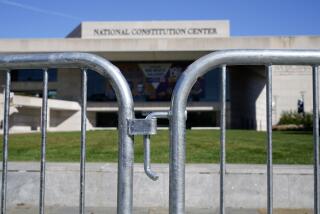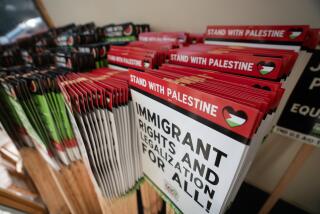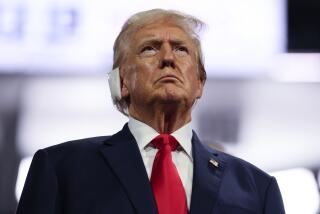Jaswant Singh
- Share via
Jaswant Singh represents India’s transition. He grew up in the British colonial days of the raj. He was a horseman in newly independent India’s first cavalry, following a long family tradition of military men. He resigned to run for office and has since served in both the upper and lower houses of India’s Parliament, where he had a reputation as a powerful orator. He’s a staunch advocate of Indian family values. He’s a passionate Hindu nationalist.
That’s the traditional India in him.
Yet, as foreign minister of the world’s most populous democracy, he has a Hotmail address for his private e-mail. During his visit to the United States last week, he toured the Nasdaq stock exchange, where he’d like to see more Indian companies listed. He read biographies of Walt Whitman and Simon Bolivar over the summer. He loves golf. Western music hums in the background of his office all day long.
That’s the new India in him.
Although virtually unknown in the United States, Singh has orchestrated the dramatic diplomatic transition in relations between India and the United States. Reciprocal state visits--President Bill Clinton to India in March and Prime Minister Atal Behari Vajpayee to Washington this month--marked a new era in relations, according to U.S. officials.
India’s press has chided Singh for his initiative.
“De-satanization of the so-called American Imperium is in full swing, and Jaswant Singh is the exorcist-in-chief,” wrote India Today magazine this summer. “India has come a long way from [former Foreign Minister Inder Kumar] Gujral’s embrace of Saddam Hussein to Singh’s Madeleine moment.”
Singh does like to show Indian journalists the inscribed photograph--”with admiration and affection”--of him and Secretary of State Madeleine K. Albright. They have already met three times this year, and Albright may visit India, where her father served in Kashmir, again this fall.
Singh’s diplomatic initiative is not limited to the United States. Although he is a senior official of the Bharatiya Janata Party, the staunchly Hindu nationalist party, the frequently flying foreign minister has a reputation for reaching out to countries once shunned by India in the days it headed the Non-Aligned Conference. He’s even visited Israel.
Singh is the first foreign minister educated in public schools. His two sons have carried on the family tradition. One is in the army reserve and participated in the bloody battle for the strategic Kargil Heights in Kashmir last year. The other ran for Parliament and lost. The foreign minister was interviewed during Prime Minister Vajpayee’s state visit to Washington this month, following their trip to the U.N. Millennium summit in New York.
*
Question: After decades of cool relations, India and the U.S. are now considered close allies, and you are widely considered the architect of the change. Why the shift?
Answer: I’m not the architect. The architect is the times, the circumstances, the transformed global situation. In the years after World War II . . . the United States felt its national interests were best served by a variety of alliances that didn’t include India. In those early years after its independence, India had to move into a position of balance between the two competing superpowers, hence, nonalignment. . . .
What we need in Indo-U.S. relations is stability and predictability. Also, the ability to engage with each other with candor, in confidence and with the sense of being able to deal with differences of approach on issues.
Q: Despite improved relations, U.S. sanctions, imposed on both India and Pakistan after their 1998 nuclear tests, remain in place. How much impact are they having on India?
Robin Wright, the diplomatic correspondent for the Times, is the author of “The Last Great Revolution: Turmoil and Transformation in Iran.”
A: We didn’t believe sanctions would have the results you expected. India has a continental-size economy that sustains 1 billion human beings. So far, sanctions have been counterproductive. Trade has grown by 27% over the last year, and it hasn’t reached its true potential because of sanctions. Exports from India are growing, and imports from the U.S. are sluggish. So you’re only hurting yourself.
Q: Do you foresee any change in India’s position on nuclear tests and signing the Comprehensive Test Ban Treaty? Under what circumstances would India use a nuclear weapon?
A: I don’t see any circumstances. We have announced a no-first-use policy. We’ve also announced no use against nonnuclear states. Weapons of mass destruction are . . . meant for the role of deterrent.
India has a voluntary moratorium on any future nuclear explosive testing. We have said we will not stand in the way of the entry into force of the Comprehensive Test Ban Treaty and that our moratorium will continue until then. . . . Since the substance of our obligation on banning explosive testing is there, we’re only looking at the style as to how you comply with that substance. We’ve said that until we have a domestic political consensus on this issue, please have patience. We intend to do it. Parliament will meet in November. It’s my expectation that we’ll have a full-fledged discussion and that the political community will eventually come around to a consensus.
Q: A recent Central Intelligence Agency estimate predicts a 40% to 60% chance of war between India and Pakistan over Kashmir in the next couple of years. What odds would you give the danger of conflict?
A: Far be it from me to comment on the U.S. intelligence system. But if you were to carry out an analysis of the historical factor of errors by this great institution [CIA], you would be better able to judge.
There are nil chances of conflict. I have something to do with policy formulation. I know what is happening and what we will do. Surely, you should appreciate that, in 1999, we were put to a severe test in [the Indian town of] Kargil [in the contested region of Kashmir], not because we wished to score points but because India is a responsible nation that believes that, as a nation, we have a responsibility to the international community, not simply to our Western neighbors. We suffered casualties. As a soldier, it saddens me. My son volunteered to be in Kashmir, and we lost over 500 men. But we conducted our policy, under the most testing times, with great restraint.
Q: Various governments dating back to Prime Minister Indira Gandhi have pledged to grant Kashmir greater autonomy. Why won’t your government follow through?
A: As far as management of our internal affairs and autonomy to states and decentralization, we had a commission established on it. I just attended an interstate council 10 days ago, and we discussed the report of that commission on granting greater functional autonomy not simply to Jammu and Kashmir but to other states of the union . . . and the government is moving toward it.
But for you to consider Jammu and Kashmir some kind of territorial dispute would really be an error. I’m astonished at times that people don’t point out that 38,000 square kilometers of Jammu and Kashmir is disputed with China and is currently under its occupation. The entire northern areas are occupied. These is the real territorial dispute.
Q: Human-rights groups have criticized India for the increasing incidents of violence against minorities, including Christian missionaries, the use of force in Kashmir and Punjab and the growing emphasis on Hindu nationalism in the new school curriculum and the emphasis on one culture, one religion and one identity.
A: Part of this is founded on misinformation, and part is an error of judgment by those who write about it. India and its government can be nothing but secular. . . . There have been some incidents, which are not against churches, and only in three states. One was purely a criminal element, and immediately the government appointed a justice of the supreme court to look into it, and a man has been arrested.
The other incidents involved a gang, which has been identified and [whose members have been] arrested, that was motivated to sully the name of India. It’s an error to say that there is any designed action against Christian communities. This is an aberration. Christians have been welcome in India since the first Christian community was established in 6 A.D.
I believe that there are no human-rights violations in Kashmir or Punjab. In Kashmir, the greatest violation of human rights is terrorist activity. When 100 innocent pilgrims on an annual pilgrimage as ancient as time--when they have to walk long distances to reach a cave--and they’re gunned down, that is the human-rights violations.
Q: India has increasingly expressed its desire for a larger role in the United Nations and other international institutions commensurate with its numbers and leadership in the developing world. What role would India play, and how might it change the balance of power in the world?
A: It’s ironic that in the early years of the Security Council, a seat was offered to India, and in an act of possibly the most profound historical abnegation, the then-prime minister said “no,” it shall not take a seat unless China first gets represented. . . . India, more than any other country--as a civilization and culturally, not just because of its membership in the nonaligned movement or the Group of 77 [developing nations]--has to give voice to those who don’t have a voice and those who are deprived and fall into the category of want. This is not just India’s duty. This is the U.N.’s obligation, too.
In terms of the balance of power, in India we have always known that the essence of power is to know the limits of power.
Q: Indians are contributing an extraordinary percentage of the expertise in developing software programs for U.S. companies, many in California. How is this changing the nature of relations between the U.S. and India?
A: Americans of Indian origin have acted as a catalyst to Indo-U.S. relations that even I didn’t see 10 years ago. [They] make up less than 1% of the U.S. population, but earn nearly twice the median U.S. income. Of the 80 national groupings that constitute the U.S., for last five years, Americans of Indian origin have consistently ranked at the top in education and income. This will play an important role as they begin influencing your thinking.
What has been the catalyst? Knowledge-based industry. New York hospital records are being maintained in Bombay because it’s more convenient. [I’ve been] told that of all the H-1B visas [for professionals], 47.5% are to Indians; 30% of all start-ups in info-tech are by Americans of Indian origins.
Q: India had one of the most innovative programs to bring women into power in the mid-1990s by allocating roughly a million seats to females in local council elections. There have been repeated efforts, all failing, to pass a similar law for national Parliament. Why is there such resistance to bringing more women into power?
A: My party and the democratic alliance is totally and unequivocally committed to it. One-third of the seats in Parliament ought to be for women. For that, we require two-thirds of Parliament to amend the constitution. We in the alliance don’t have two-thirds. We have tried to introduce the bill. Whenever we try to introduce this bill, we meet a filibustering resistance. We will do it again in the winter session in November. We will not be defeated in this purpose.
Q: The government claims Prime Minister Vajpayee’s recent health problems are related to his knees and a sore throat. Yet, he canceled the joint press conference with President Bill Clinton and he looked rather frail during his visit.
A: He’s in fine heath. He has a knee problem, which he’ll have attended to when he returns to India.
More to Read
Sign up for Essential California
The most important California stories and recommendations in your inbox every morning.
You may occasionally receive promotional content from the Los Angeles Times.













